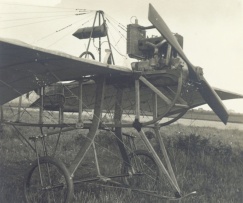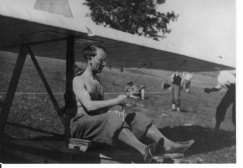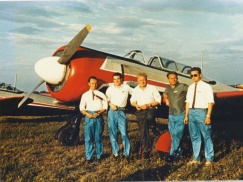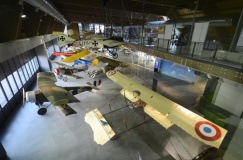History of aviation in Mladá Boleslav |
|
History of aviation in Mladá Boleslav - from Metoděj Vlach to the present day
It began with Vlach and Hieronymus
Ing. Otto Hieronymus, the German chief designer at the Laurin and Klement Company and excelled not only as an engine engineer, but also as a car racer and aviator, was a comntemporary of Metoděj Vlach. He built the first aircraft engine at this company under the Hiero I name, which was later modified and mass-produced in Vienna‘s New Town as the first aircraft engine in the Austro-Hungarian Empire. Ing. Otto Hieronymus flew in the Blériot aircraft in Prague -Chuchle in April 1910 and in Mladá Boleslav at the military training camp in Radouč. This aircraft was fitted with his Hiero engine. In the period from 1925 to 1927, the Laurin and Klement Company produced large aircraft engines under a licence granted by the French company Lorraine-Dietrich. They were powerful twelve-valve engines producing 450 horsepower. One of these is now exhibited at the Škoda Auto Museum. Among the major points of interest is the long-haul flight in the Šmolík Š 16 two-seater open aircraft from Prague to Tokyo in 1927, which was propelled by precisely this engine.
Masaryk's Aviation League Of great importance for aviation in Mladá Boleslav was the establishment in the area of Masaryk Aviation League (MAL), which was the predecessor of the later aero club. The founding meeting took place on 10April 1926, and was attended by 182 people, headed up by the mayor of Mladá Boleslav. Mr Václav Klement, the general counsel of the Škoda Works, was elected as the first chairman. An aviation mechanics department was established at the technical school in 1930. Students constructed gliders in the school's workshops. In 1931, a modelling division was established at MAL, with a workshop in the technical school. That year, the air show once again took place in Radouč.
Airport at Radouč and on Chlum.
A new airport was built on the Chlum Hill in 1936 with the help of an technical school. The starting point was about 130 metres above the landing site. A small hangar was also built here.
Post-war aviation activity at the Belveder Airport After the war, aviation activity moved to the current Belveder Airport. The hangar at Chlum was dismantled by volunteers and erected at the new airport. Another hangar was built besides this airport using material obtained free of charge from a bombed-out automobile factory. After their completion, hangars were gradually filled with aircraft. These included the Z-24 Krajánek, Z-25 Šohaj and Z-130 Kmotr gliders. The first engine-propelled aircraft were the Praga Baby E-114 and the Z-381 Bücker. Aviation activity flourished and the first flyovers were also launched. But this also brought the first accidents. During the May Day celebrations held on 1 May 1950, the aviators Tyrner and Kcheml were meant to drop a ball from a Praga E-114 aircraft onto a football pitch. But both flyers perished when the aircraft crashed. Fortunately, not on the crowd gathered below. SVAZARM (The Union for Co-operation with the Army) and its aero clubs were established in 1952 and large recruitment drives commenced at schools and non-motorised aviation trade schools. In the 1970s, four Jak C-11 aircraft led by Jaroslav Rákos can be seen flying in Mladá Boleslav. The group's members were Jaroslav Tomeš, Antonín Dytrych and Miroslav Kapras. In 1967, aviation activity was extended by the addition of helicopter training.
Sports flying activity was preserved mainly thanks to the enthusiasm of individual pilots and their willingness to devote all their leisure time and effort to their sport.
New aviation era after 1989 After a change in the overall situation, there was also a rapid change in the flying conditions. Of course, this is not an overnight change, but during the first 10 years after 1989 flying at the aero club once again develops, just as we had always wanted. It becomes a hobby again and brings joy to those who dedicate themselves to it. The training of new pilots is a means, rather than an end, of maintaining and developing aero club life. This brings sustained development in the sports activity field. This brings about the gradual revival of various competitions and races. The Gradient Gran Prix glider competition has been held in Mladá Boleslav since 2008. Several members are involved in glider acrobatics, which also brings about an increase in the number of aerobatics races for gliders. This gradual development once again triggers the organisation of an "air fest" in the form of the Historical Air Show flight days, which, thanks to co-operation with the Metoděj Vlach's Aircraft Foundation, began in 2002. At the same time, the 1990s witnessed the beginning of a new era of aviation activity in Mladá Boleslav in the form of ultra light aircraft. The first aviation companies, such as Bestar in Kosmonosy, are also established, where the American Rans Coyote aircraft are serially produced from kits. At the beginning of the twenty-first century, Metoděj Vlach's Aircraft Foundation was founded in order to build its replica and to bring this interesting but now forgotten figure of Czech aviation to public attention. The city established a foundation fund, the Škoda Company made a favorit engine available on loan, and in June 2002 a replica of the first Czech aircraft, which was built by Metoděj Vlach in 1912, first took off into the skies. The presentation of the replica of Metoděj Vlach's aircraft began marked the start of the era of Period Air Days, which made Mladá Boleslav famous both in the Czech Republic and abroad. Interesting historical aircrafts from all over Europe are gathered here every two years and this event has become very prestigious and European. In 2007, the foundation fund, in co-operation with the city and other partners, built a monument to Metoděj Vlach exactly at the site where he first started his aircraft on 8 November 1912.
The Metoděj Vlach Aviation Museum and the current airport The beautiful building housing the Metoděj Vlach Aviation Museum was constructed in 2015 by the Central Bohemia Region. This museum currently houses 28 aircraft, of which 22 is fully operational and capable of flight. These aircraft are regularly shown to the public in flight as part the "We Fly for You" events. Mladá Boleslav Airport lives. Aircraft from the aero club and the aviation museum, as well as Nisa Air helicopters, take off from this airport. This airport is used for tandem jumps as well as sightseeing flights, and a visual treat always in stall for visitors to the museum's aviation canteen. Metoděj Vlach, who would have celebrated his 130th birthday on July 7, would surely be pleased with our current aviation activities.
|



 In 1909, Metoděj Vlach, who was 22 at the time and worked for the Laurin and Klement Company as an engine fitter, started working on constructing an aircraft. He built a total of four aircraft, of which three did not fly, but only "jumped" up to a height of one metre. At that time, aircraft did not have good flying properties, and were almost always damaged during testing. In 1910, he commenced work on building a monoplane with his friends, the construction of which was completed in April 1912. Mr Vlach first flew this aircraft in Mladá Boleslav on 8 November 1912 at the site where his memorial now stands, which is at the crossroads of Havlíčkova and Bezručova streets.
In 1909, Metoděj Vlach, who was 22 at the time and worked for the Laurin and Klement Company as an engine fitter, started working on constructing an aircraft. He built a total of four aircraft, of which three did not fly, but only "jumped" up to a height of one metre. At that time, aircraft did not have good flying properties, and were almost always damaged during testing. In 1910, he commenced work on building a monoplane with his friends, the construction of which was completed in April 1912. Mr Vlach first flew this aircraft in Mladá Boleslav on 8 November 1912 at the site where his memorial now stands, which is at the crossroads of Havlíčkova and Bezručova streets. The site at Radouč was approved by the Ministry of Public Works as a glider airport. As this airport had no hangar, the aircraft were stored at the technical school and had to be transported to the runway prior to flight by cart, assembled there, and then disassembled after the flight and taken back to the technical school. The hangar was not built until 1937.
The site at Radouč was approved by the Ministry of Public Works as a glider airport. As this airport had no hangar, the aircraft were stored at the technical school and had to be transported to the runway prior to flight by cart, assembled there, and then disassembled after the flight and taken back to the technical school. The hangar was not built until 1937. The fate of the C-11 aircraft can be used to illustrate the situation in sports flying at the end of the socialist regime. The collapsing economic system was unable to keep these historical aircraft in operation, meaning that instead of being overhauled, they were shut down and were never flown again. Some ended in the air museum and one was donated to DOSAF, a "sister organisation" in the former USSR. Similar events unfurled in all aero clubs of the then Czechoslovakia, including in Mladá Boleslav. The standard of sports flying gradually deteriorated and the aero club focused mainly on the training of pilots and paratroopers, in respect of whom the assumption was that they would continue flying and skydiving with the army.
The fate of the C-11 aircraft can be used to illustrate the situation in sports flying at the end of the socialist regime. The collapsing economic system was unable to keep these historical aircraft in operation, meaning that instead of being overhauled, they were shut down and were never flown again. Some ended in the air museum and one was donated to DOSAF, a "sister organisation" in the former USSR. Similar events unfurled in all aero clubs of the then Czechoslovakia, including in Mladá Boleslav. The standard of sports flying gradually deteriorated and the aero club focused mainly on the training of pilots and paratroopers, in respect of whom the assumption was that they would continue flying and skydiving with the army.